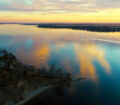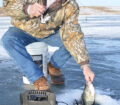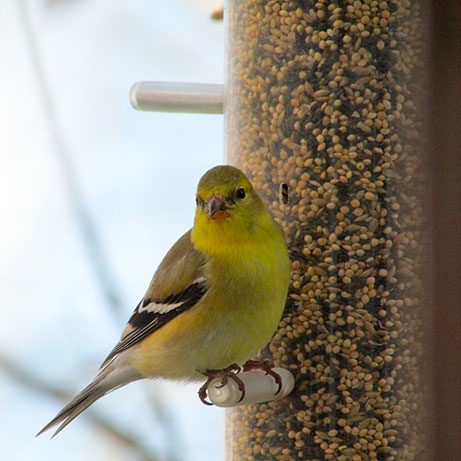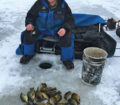By Steve Weisman
Each November the Iowa Great Lakes Fishing Club (IGLFC) hosts its annual fall Department of Natural Resources (DNR) night at Oak Hill Outdoor on the north side of Milford. With over 350 members, the goal is to get as many members as possible there to learn more about the efforts of the law enforcement and fisheries biologists across northwest Iowa.
With nearly 200 people in attendance, the evening was filled with updates, good food (55 jumbo pizzas consumed), raffle results and winners (over $4,000 made on the large raffle project) and updates from DNR personnel on the past year.
According to board member Paul Daniels, “We also had a record event for new member sign-ups with 19 and another 84 member renewals.”
Greg Harson, District Conservation Officer Supervisor in northwest Iowa, shared law enforcement updates. The water patrol program is a major part of water safety on the Iowa Great Lakes area. Harson noted, “We usually bring 8-12 seasonal workers up here to work and patrol during the summer. It’s a big body of water, a big complex up here that we need a lot of coverage on. They put on 3,000 to 5,000 hours on the water each summer. Each person goes through a pretty rigorous preparation with a two-week training at Camp Dodge and then we bring them up here and put them on the water and prepare them for their summer job. These jobs offer a lot of experience for these 20–21-year-olds. The job recruitment is huge.”
Harson also discussed Executive Order 10, signed by Governor Reynolds, that requires all state agencies to go through all their administrative rule chapters and identify which should be retained and which should be eliminated. Harson encouraged Iowans to become involved and make recommendations from the public’s standpoint. Public meeting opportunities will be set up after the first of the year, so look for DNR press releases or check out the Iowa DNR website for more information
Fisheries Management
Kim Hawkins, Spirit Lake Hatchery manager, shared the results of both the Spirit Lake and Rathbun hatchery efforts. First off, it is well known that without the stocking and restocking, there would be a small walleye population in Iowa.
Of the 74,000,000 fry produced at Spirit Lake, 75 percent of that goes back into the four broodstock lakes: Spirit Lake (20,748,455), Clear Lake (15,015,106), Storm Lake (13,945,641) and East Okoboji/West Okoboji Lakes (6,543,359). At the same time, over thirty-five lakes receive fry stockings, including: Black Hawk, Center, Five Island, Ingham, Iowa Lake, Little Spirit Lake, Lost Island, Pickerel, Silver (Dickinson Co.), Silver (Palo Alto Co) and Tuttle Lake in Northwest Iowa. Meanwhile, 300,000 two-inch Walleyes are stock in the summer on seven different stretches of Northwest Iowa rivers, including: Little Sioux River, Big Sioux River and East/West Forks of the Des Moines River.
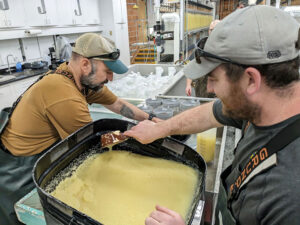
Cleaning and jarring walleye eggs.
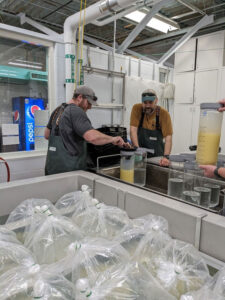
Bags of walleye eggs waiting to be jarred from Storm and Clear Lake stations
This past fall, the hatchery personnel stocked 120,000 fingerling walleyes (7-8”) with nearly 100,000 of them raised at their rearing pond: Welch Lake. These fish are distributed in lakes that have a gap in fry year class. Meanwhile, the Rathbun Hatchery raised 90,000 (8-9”) fingerlings and stocked them into eight waterbodies.
Hawkins also noted that the Rathbun Hatchery does the same thing with the 95,000,000 fry reared at Rathbun going to 15 lakes in central and southern Iowa, along with over 680,000 two-inch Walleyes being stocked into 14 central and eastern Iowa rivers stretches. Rathbun Hatchery is able to raise 24,000,000 more walleye fry and more walleye fingerlings than Spirit Lake because of their larger facility.
Another stocking program from the Spirit Lake Hatchery includes stocking 1,500,000 northern pike fry into 12 water bodies including several shallow lakes in the area. Yearling muskies are also stocked with 2,400 going into eight Iowa lakes.
One of the little-known facts is that Iowa DNR fishery agencies will trade fish with other fisheries agencies in other Midwest states in order to bolster populations and diversity of fish that are not raised in Iowa hatcheries.
Research
Much of the research done in northwest Iowa is led by Fisheries Research Biologist, Jonathan Meerbeek. One of the most recent is a study of walleye populations in the satellite lakes in northwest Iowa. These are lakes in which walleyes are stocked but because of lack of manpower and time, yearly studies are not done. The primary goal of this study is to document where fry survival was adequate enough to provide “a chance” of a good walleye year class.
Crews accomplish this by sampling each lake using a 50 foot seine at four locations during August to examine the number and size of young of the year fish. Then, electrofishing is used during fall to determine if walleye young of the year numbers are sufficient and also determine the adult walleye size and age structure. Collectively, these efforts are designed to document growth, recruitment and mortality.
According to Meerbeek, “This gives us data to make future stocking and management decisions. In addition, many of these lakes get fingerling stockings. Fingerlings are expensive, and we want to make sure that we are not just stocking them on top of an already good young-of-the-year class. So, these surveys help us determine their survival rates.”
Overall, fry stocking success in 2023 was good for many of Iowa’s natural lakes. In particular, stocked walleye fry survived exceptionally well at Five Island Lake, where 257 young fish were caught in the seine and electrofishing surveys caught 852 young walleye. “Catch rates at Five Island were the most I have ever seen,” said Meerbeek. “So, it should be looking good there for recruitment.” Another five lakes were also good with an average of over 50 young walleye sampled: Cornelia, Ingham, Silver (Dickinson) Silver (Palo Alto) and Tuttle lakes.
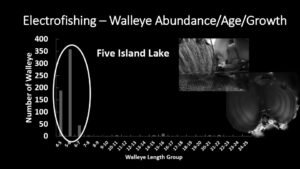
Electrofishing walleye abundance at five Island Lake
Meanwhile, both East Lake Okoboji and Lost Island lakes showed very little young-of-the-year recruitment. “With this data, we now know to stock those lakes more with our fall fingerling product.”
At the same time, Meerbeek discussed the numbers of angler-catchable walleyes sampled in these satellite lakes during electrofishing investigations. Ingham Lake, Lost Island and Silver Lake (Dickinson Co.) all showed over 50 walleyes taken per outing.
The more data collected on these lakes will result in more efficient use of DNR walleye stockings, more consistent walleye year classes, and ultimately equate to more angler success!

